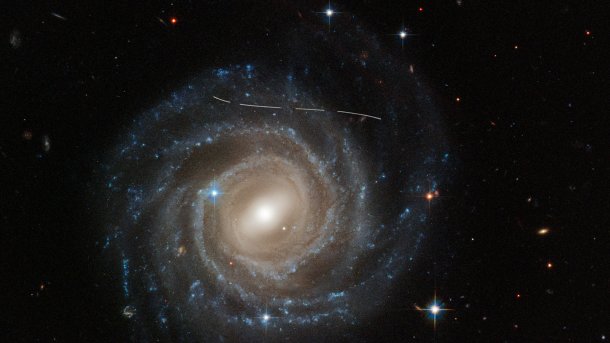Astronomy: Over 1000 unknown asteroids discovered in old Hubble images
Thousands of volunteers have helped search old images from the Hubble Space Telescope for traces of asteroids. The work is now complete.
An asteroid as a photobomb in front of the galaxy UGC 12158
(Bild: NASA, ESA, P. G. Martín (Autonomous University of Madrid), J. DePasquale (STScI)/A. Filippenko (University of California, Berkeley))
(Bild: NASA, ESA, P. G. Martín (Autonomous University of Madrid), E. Wheatley (STScI))
In old images taken by the Hubble Space Telescope, volunteers supported by AI technology have now found the tracks of more than 1000 previously unknown asteroids. Most of them have a diameter of less than one kilometer, the European Space Agency has now announced. For the treasure hunt, as the ESA calls the work, 37,000 archived images taken over a period of 19 years were examined. The sample that has now been analyzed could also help to determine the history of the formation of the asteroid belt between Mars and Jupiter. It is therefore more likely to be the remnants of numerous collisions and not made up of objects that have grown since the early days of the solar system.
Indication of the history of the asteroid belt's formation
According to research leader Pablo García Martín from the Autonomous University of Madrid, the number of asteroids found was a surprise. Until now, there had only been indications that a large population of comparatively small asteroids existed in the asteroid belt. The sample now supports the theory that the many small asteroids there are fragments of larger asteroids that have collided and broken apart in the process. This is a process that has taken billions of years. According to an alternative explanation, the asteroids gathered there grew like snowballs over an equally long period of time. However, the findings now presented would not fit this explanation.
For their work, the researchers took advantage of the fact that Hubble orbits the sun on a known path - in Earth's orbit - and photographs the universe from there. Asteroids in the solar system leave dsitinct lines on the images, from which their orbits can be determined. However, because the research group was unable to search through all the archive images themselves, they first trained an AI technology and then enlisted the help of volunteers. More than 12,000 volunteers took part in the process and thus contributed to the findings. Those responsible believe that this approach should be transferable to other data sets.
(mho)
